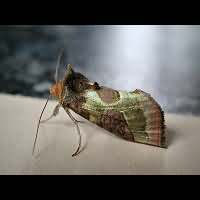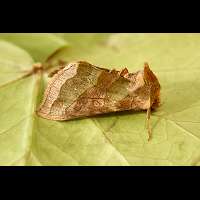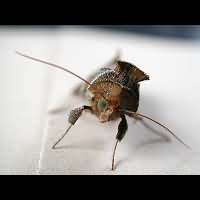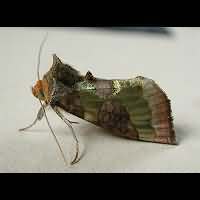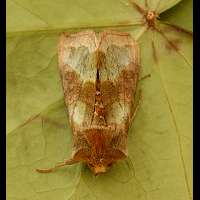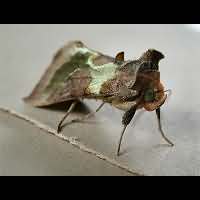Burnished Brass Diachrysia chrysitis
The Burnished Brass is a beautiful and unmistakable moth: it has two big brass like blobs on the wings. The colour of these metallic scales varies from yellow brass to greenish brass. The two blobs may be connected by a small band, but they may be completely separated as well. Two species are more or less similar. The Scarce Burnished Brass has just one blob of metallic scales, is larger and has a darker colour. It is a very local species, which you probably won't see outside Hampshire, Wiltshire, Berkshire and Southwest Wales. The Slender Burnished Brass is also similar, but it is a very rare immigrant from Southern Europe. The Burnished Brass has a wingspan of 34 to 44 mm.
The second generation of moths deposits the eggs in August mainly. The are attached separately on the underside of leaves and hatch after just one week. The caterpillars feed by night and hide during the day in leaves folded together. They don't grow very fast and when the leaves start to drop to the ground in autumn, they fall with them and spend winter between them. Depending on the weather they start feeding again in March or April. Burnished Brass pupates in a light brown cocoon attached to leaves. From May the first moths appear. They usually take care of a summer generation, flying about in July and August. The caterpillars look like those of Geometer Worms, for they have only three pair of abdominal legs. They are of a blueish green colour. On the back is a line up of white arrowshaped markings. The spiracula have a black border and are covered by a clear white line. The foodplants are various nettles, but this species is also reported from marjoram. It will reach a length of some 30 to 36 mm.
The Burnished Brass is on the wing from May to October in Southern Britain, where it is double brooded. In Northern Britain seen from June to August only. Sometimes flies during the day, even sucking nectar. Flies in dusk regularly and is seen visiting flowers from various plants, such as Buddleia, Valerian and thistles, including many garden flowers. Often seen in the vicinity of man and a very common species in parks and gardens. Comes to light in small numbers, usually after midnight. A very common species on the continent as well.
The Burnished Brass is a beautiful and unmistakable moth: it has two big brass like blobs on the wings. The colour of these metallic scales varies from yellow brass to greenish brass. The two blobs may be connected by a small band, but they may be completely separated as well. Two species are more or less similar. The Scarce Burnished Brass has just one blob of metallic scales, is larger and has a darker colour. It is a very local species, which you probably won't see outside Hampshire, Wiltshire, Berkshire and Southwest Wales. The Slender Burnished Brass is also similar, but it is a very rare immigrant from Southern Europe. The Burnished Brass has a wingspan of 34 to 44 mm.
The second generation of moths deposits the eggs in August mainly. The are attached separately on the underside of leaves and hatch after just one week. The caterpillars feed by night and hide during the day in leaves folded together. They don't grow very fast and when the leaves start to drop to the ground in autumn, they fall with them and spend winter between them. Depending on the weather they start feeding again in March or April. Burnished Brass pupates in a light brown cocoon attached to leaves. From May the first moths appear. They usually take care of a summer generation, flying about in July and August. The caterpillars look like those of Geometer Worms, for they have only three pair of abdominal legs. They are of a blueish green colour. On the back is a line up of white arrowshaped markings. The spiracula have a black border and are covered by a clear white line. The foodplants are various nettles, but this species is also reported from marjoram. It will reach a length of some 30 to 36 mm.
The Burnished Brass is on the wing from May to October in Southern Britain, where it is double brooded. In Northern Britain seen from June to August only. Sometimes flies during the day, even sucking nectar. Flies in dusk regularly and is seen visiting flowers from various plants, such as Buddleia, Valerian and thistles, including many garden flowers. Often seen in the vicinity of man and a very common species in parks and gardens. Comes to light in small numbers, usually after midnight. A very common species on the continent as well.

